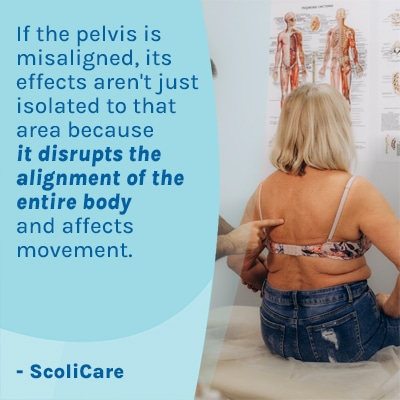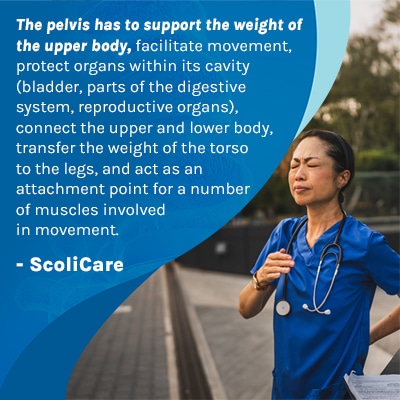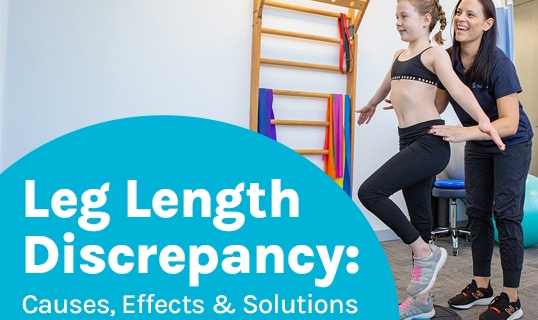A body’s balance and stability is based on many factors, including its symmetry and alignment. Given the importance of the pelvis in facilitating healthy movement patterns and supporting upper body weight, a disruption in its position can have a number of effects.
Pelvic obliquity causes the pelvis to become unnaturally tilted, causing one hip to sit higher than the other. Pelvic obliquity can disrupt posture, movement, and cause pain. Common causes include uneven bones in the pelvis, leg length discrepancy, and hip contractures.
For a better understanding of how pelvic obliquity can affect the body, let’s explore the important roles of the pelvis.
What Does the Pelvis Do?
The pelvis is a bony structure consisting of the sacrum (triangular bone at the base of the spine), the coccyx (tailbone), and two hip bones.
There is a pelvic cavity containing various organs, and the pelvic floor muscles support the pelvic organs and facilitate continence and sexual function.
The pelvic joints allow for some flexibility and movement, while maintaining stability.
The pelvis has to support the weight of the upper body, facilitate movement, protect organs within its cavity (bladder, parts of the digestive system, reproductive organs), connect the upper and lower body, transfer the weight of the torso to the legs, and act as an attachment point for a number of muscles involved in movement.
So as you can see, the pelvis is a key structure with a number of functions.
So what can cause the pelvis to become unnaturally tilted?
Pelvic Obliquity Causes
Pelvic obliquity can have a number of causes from the presence of an unnatural spinal curve disrupting the position of the pelvis to leg length discrepancy and issues with hip-joint mobility.
A misalignment in the body can cause a number of effects that aren’t just isolated to the area of the misalignment.
Scoliosis and Pelvic Obliquity
Scoliosis, for example, causes an unnatural lateral spinal curve to develop that also rotates, and this is capable of disrupting the alignment and symmetry of the entire body through postural and movement changes.
Scoliosis is also progressive, meaning without treatment, its nature is to get worse over time, and as the spine is so key to the body’s health and structure, an unhealthy spine can have many effects.
The main symptom of childhood scoliosis is postural deviation, including uneven shoulders, shoulder blades, a rib cage arch, and uneven hips.
In fact, in many cases, uneven shoulders and hips are the earliest indicators of scoliosis.
So if the uneven forces of scoliosis are causing postural changes, uneven weight distribution and pressure on the pelvis, it can alter its position and cause one hip to sit higher than the other.
Scoliosis causes an unnatural lateral spinal curve, uneven hips, and a lateral pelvic tilt can develop as a result if enough uneven pressure is occurring.
A Leg Length Discrepancy

A leg length discrepancy involves the legs being unequal in length, and this can cause pelvic obliquity (1).
The tilt in the pelvis can be caused by a structural leg length discrepancy or a functional leg length discrepancy.
A structural difference in leg lengths is caused by anatomical differences in the length of the leg bones, or it can be caused by a functional difference whereby it seems the legs are uneven but this can be caused by a misalignment elsewhere in the body (1).
Pelvic obliquity can occasionally develop as the body’s way to compensate for the unequal leg length.
So a leg length discrepancy that causes pelvic obliquity can also lead to scoliosis, most often, as a lumbar (lower back) or thoracolumbar (between the upper and lower back) scoliosis, and in some cases, scoliosis can cause the pelvis to tilt unnaturally.
Initially this may only be a functional scoliosis where there is a lateral deviation of the spine but no rotation (2), but over time, this can turn structural.
Hip Contractures
Hip contractures cause limited hip movement due to stiff joints or tight muscles (2).
A hip contracture can cause pelvic obliquity by disrupting the natural movement of the hip; the body can compensate by tilting the pelvis to counteract the uneven movement in the hip and maintain an economical gait (3).
The body is symmetrical in design, so it will compensate in a number of ways to maintain its symmetry and alignment.
Effects of Pelvic Obliquity
A misaligned body can cause a number of effects, and pelvic obliquity can develop due to an unnatural spinal curve causing postural changes and introducing uneven forces, or it can develop as a body compensation in response to a leg length discrepancy or hip contractures (1, 2, 3).
If the pelvis is misaligned, its effects aren’t just isolated to that area because it disrupts the alignment of the entire body and affects movement.
Various effects can develop:
- Postural issues
- Pain in the lower back, hip, and legs
- Development of a gait abnormality
- Increased risk of injury in the back, hip, and joints
- Can cause an unnatural spinal curve to develop (scoliosis)
- Can impact walking, sitting, standing
A misaligned pelvis can cause uneven wear and tear on the body: its muscles, joints, and the spine.
If pelvic obliquity is left unaddressed, it’s likely to worsen, particularly when involving progressive scoliosis.
If any type of misalignment in the body is left unaddressed, it’s likely to worsen over time, particularly as natural age-related degeneration starts to occur, and a misalignment can increase a person’s level and rate of degenerative changes, particularly in the joints and spine.
Pelvic Obliquity Treatment Strategies
A misaligned pelvis needs to be addressed, and the sooner, the better to prevent the effects of uneven wear on the lower body and changes to healthy movement patterns.
For long-term treatment results, the underlying cause of the misaligned pelvis has to be addressed, and if it’s scoliosis, the unnatural spinal curve that’s causing the pelvis to tilt unnaturally has to be corrected.
Scoliosis Correction
Scoliosis treatment plans need to be customized; in many cases, scoliosis can be highly treatable (1, 2).
Nonsurgical scoliosis correction can be worked towards through a combination of corrective bracing and scoliosis-specific exercise programs that work together to restore alignment and balance to the spine and body.
The ScoliBrace® and ScoliBalance® are evidence-based and individualized; ScoliBrace® is the leader in modern corrective bracing and harnesses spinal couplin

g to improve the spine’s position and body posture for 3-dimensional correction.
ScoliBalance® is a scoliosis-specific exercise program that teaches patients how to hold their spine and body during movement to best counteract the scoliosis and hold corrective treatment results.
This approach relies on the power of Mirror Image® exercise to teach patients postural awareness that they can apply to daily activities for a spine- and scoliosis-friendly lifestyle.
Using exercise to improve the spine’s surrounding muscle balance and strength means a spine with more support and stability.
Leg Length Balancing
If the pelvic obliquity has developed as a body compensation for a leg length discrepancy, leg length balancing is necessary to restore the symmetry of the lower body and halt the effects of a gait abnormality.
A common nonsurgical strategy for leg length balancing is the use of short inserts, and if the unequal leg length is caused by a misalignment elsewhere in the body interrupting movement and posture, the cause of the misalignment needs to be addressed (2).
Hip Health
If hip contractures have caused the unnatural tilt in the pelvis, the hip displacement needs to be addressed.
Hip contractures involve shortened hip muscles affecting joint mobility, so physical therapy is a common treatment response that works towards restoring the hip’s strength and flexibility, improving muscle tone and strength, and reducing pain (3).
Conclusion
Pelvic obliquity involves the pelvis becoming unnaturally tilted, and an adequate correction is needed to restore balance and alignment to the pelvis and lower body because if left untreated, it can further disrupt the biomechanics and alignment of the entire body.
Pelvic obliquity can develop due to a spinal condition like scoliosis that causes the lower back to curve and twist unnaturally, and in these cases, scoliosis correction is necessary to remove the uneven forces causing the pelvis to tilt unnaturally.
If unequal leg length is the cause, a shoe lift or custom orthotic is a common response when the discrepancy is structural, and when there is a functional leg length discrepancy, the cause of postural and/or movement changes affecting muscle balance has to be identified and addressed.
If hip contractures have altered the hip’s healthy range of motion, the pelvis can compensate by tilting to counteract the changes in hip movement, so the hip’s range of motion needs to be restored; this commonly involves physical therapy and stretches applied to improve muscular balance, strength, and support.
It’s important to understand the role of healthy posture. Standing upright and in a neutral and aligned position doesn’t just ensure healthy movement patterns, it’s also important for joint and muscle health.
References:
- Zuckerman SL, Lai CS, Shen Y, Cerpa M, Lee NJ, Kerolus MG, Ha AS, Buchanan IA, Leung E, Lehman RA, Lenke LG. Understanding the role of pelvic obliquity and leg length discrepancy in adult spinal deformity patients with coronal malalignment: unlocking the black box. J Neurosurg Spine. 2022 Jan 14;37(1):64-72. doi: 10.3171/2021.10.SPINE21800. PMID: 35171835.
- Raczkowski JW, Daniszewska B, Zolynski K. Functional scoliosis caused by leg length discrepancy. Arch Med Sci. 2010 Jun 30;6(3):393-8. doi: 10.5114/aoms.2010.14262. PMID: 22371777; PMCID: PMC3282518
- Uğur F, Gürbüz İ, Köken ÖY, Kurt ANÇ, Yılmaz Ö. Pelvic obliquity, trunk control, and motor function: an exploratory study in a non-ambulatory Duchenne muscular dystrophy cohort. Rev Assoc Med Bras (1992). 2024 Dec 2;70(12):e20241109. doi: 10.1590/1806-9282.20241109. PMID: 39630734; PMCID: PMC11639577
The post Pelvic Obliquity: Causes, Effects & Treatment Strategies appeared first on ScoliCare.


